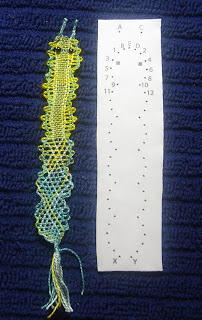Galina Khmeleva kept us occupied knitting samples day and night (homework!), and I learned a lot from her. I took all of her classes: Orenburg Shawl Fundamentals (knitting a gossamer web shawl), Knitting a Warm Shawl, and Dimensional Knitting (spiders and bobbles). Of course, there were the other classes on lace-making: Needle Lace, Bobbin Lace and Tatting. Since the Dimensional Knitting classes were repeated, I was able to take a sniffer class in Bobbin Lace which was interesting, but it's not my cup of tea at the moment. Here is the result of an hour's worth of effort:
 Beginner's Bookworm - I did most of the top half, then the instructor
Beginner's Bookworm - I did most of the top half, then the instructor(a very patient Maria Provencher) finished the bottom half, because
I was running out of time.
There were 2 classes per day: one morning and one afternoon session (10:30 to 1:00 pm and 3:00 to 5:30 pm), which gave us a rather long lunch break, but enabled us to catch up on our sample-knitting. This was our workshop area (former software office):
 And one dedicated lunch-break knitter:
And one dedicated lunch-break knitter:Orenburg Fundamentals Class: Galina took us through the making of a sample gossamer shawl, as described in her books, but with more information and tips.
She started out by making us knit samples of the basic Orenburg patterns (Strawberries, Honeycomb, Peas, etc.) in yarn she provided - I found out that I had been knitting with needles too large (2.5 mm) and she made me switch to 1.5 mm (US 000) needles, because the holes should not quite be big enough for your pinkie to slip through. Using the smaller needles indeed made my stitches more defined and neater (see bottom, green portion of the sampler - unfortunately, the picture is not that great - the difference is actually visible):
To the left of it you see two squares grafted together on two sides using the Russian grafting method.
Warm Shawl Class: In contrast to a gossamer shawl, a warm shawl is knitted in pieces: You knit 2 (for a triangular shawl) or 4 (for a square shawl) trapezoid border pieces; you pick up stitches on the short side and knit a "bridge" on each piece; then you graft 2 (for a triangular shawl) or 3 (for a square shawl) pieces together and start knitting the center (picking up border stitches as you work), then you attach the top trapezoid border (for the square version) or a border (for a triangular shawl). The bridge (not in the sample pictured) gives a warm shawl more stability, so it keeps its shape better than a gossamer shawl, which would have to be blocked more frequently with wear.
To make a triangular shawl the pink and yellow pieces one have been grafted together; then the stitches on the short pink one were picked up, and the center (turquoise) was knitted up from the pink, decreasing stitches on its left side to produce a straight line for the triangular shawl's long (diagonal) side. If you wanted to knit a square shawl, you would graft the taupe trapezoid to the yellow one, pick up the yellow top stitches and knit straight up, picking up stitches from both the pink and taupe pieces as you knit up. Then attach another trapezoid piece on top to finish the shawl. Galina will have a pattern for a triangular warm shawl in the next issue of Piecework magazine (May/June 2009).
We also received plenty of good information on yarn characteristics. For instance: Alpaca wool (I had considered it for my first real O-shawl) is not a good choice for shawls and tablecloths etc., because it has almost no memory. Also, a very fuzzy yarn like 100% Qiviuk or cashmere is not good for gossamers, because the fuzziness will cover up the holes which you want visible ("Don't cover up your hard work!"). It should be knitted together with some silk, so it keeps its shape and stitch definition better. 100% cashmere and quiviuk are better for warm shawls, because warm shawls have a less lacy (= fewer holes) design, in order to ... keep you warm.
Galina also showed us howe to properly block an Orenburg shawl (it was a method new to me), and entertained us with lots of stories from Russia (even what to do, Russian-style, with an unfaithful husband!). To top it off, she had boxes and boxes of beautiful yarns, and cloud-soft shawls on display for us (no photos of these, but we were allowed to take notes of the patterns). The most spectacular one was knitted by her mentor Olga Fedorova, who passed away last year.
Galina's class was very good and enjoyable - if you have a chance, take a class from her! Next, she will be at Stitches West in Santa Clara, California and then at the Black Sheep Gathering in Oregon, where she will teach Orenburg-style spinning.
The only negative thing I have to report is that the Lacis Museum was hospitable only in so far as providing a venue was concerned. On the first day, when I signed up for all of Galina's classes (which were the only reason I signed up for this retreat), Mr. Kliot gave me a somewhat disapproving look, because apparently his vision was that everyone should be taking classes in all types of lace-making. Well, I do not have any interest in the other forms of lace-making at this time, because I am just starting to explore lace knitting. It would also have been nice if the museum had provided a little welcome package - maybe with a map to the locations mentioned on their website, since many participants were not local ... or ... dare I say it? ... a coupon good for xx% off something in the store?
In the morning of the first day there was a "Round Table" - which I expected was where the instructors would be introduced and maybe give us a little overview of their particular craft. Instead Mr. Kliot, who did not even bother to introduce himself, only gave a little talk about how we should try out all the different methods of lace-making. Anyway, the round table turned out to be tables set up by the instructors:
 "Round Table" - Left foreground: Galina's table with some of her scrumptious shawls, left background: bobbin lace, center: needle lace, right: tatting.
"Round Table" - Left foreground: Galina's table with some of her scrumptious shawls, left background: bobbin lace, center: needle lace, right: tatting.So I felt that a good part of the first day (the first actual class did not start until the afternoon) was wasted - additionally, no spaces were assigned to the different instructors, so you had no place to put your bag(s). Oh well ... But, all in all, the classes and instructors were great, and that was the reason I went.
And this is what you see on entering the workshop area:









I appreciate the good coverage of your Khmeleva classes. I am trying to decide which ones to take, so this helps, thank you.
ReplyDeleteRegarding Lacis hospitality: I heard that the woman who was going to run the workshop was called away due to an unexpected death in the family. If true, that would explain the hospitality puzzle.